Showing top 0 results 0 results found
Showing top 0 results 0 results found

I’m sure you’ve received at least one cold email in your life. In fact, I’m almost 100% sure that you’ve received thousands of them.
What did you do with most of them? I bet you’ve either deleted them straight away or left them without responding. And I can assure you that you’re not alone.
According to the study published by The Radicati Group, office workers receive on average 120 emails a day and send out about 40. That’s a lot of emails to go through and at least some of them are cold emails that simply go unresponded.
Is there anything you can do about it?
The simple answer is: yes, there is. Instead of looking for the next cold email template, you could focus on creating what I would call warm emails.
What are warm emails (as opposed to cold emails)?
They are the perfect antidote to cold emails that no one reads, and will help you make sure that your messages get a) opened, b) read and replied to.
Here’s a list of 10 things you should consider when writing and sending out your warm emails. Please note that you don’t need to use all of these tips at once, they’re supposed to be more of a guideline than a structured template. Because the truth is:
The perfect cold email template doesn't exist.
Read on to find what you could do instead.
1. Don’t forget about the subject line
It may sound obvious, but it is - in fact - the subject line that gets your emails opened in the first place. Yes, you have only a few seconds of your potential customer’s attention, so it's better to get it right.
Which approaches to subject lines I’ve found more effective in my email campaigns?
- Keep it casual: avoid using caps, capital letters, or jargon. Don’t include things such as ‘re:’ neither. They look spammy.
- Use humor: there’s nothing that gets more people to open that email than a good punch line.
- Be human: you don’t want to sound like a robot. Also, including your contact’s name will make them hooked from the second they see it.
- Fewer words: using lengthy email subjects will decrease your open rate as most email clients display just the very beginning of the tile on mobile.
As I've mentioned, the length of your email title does matter. Here’s how the same subject lines will look like in different email clients:
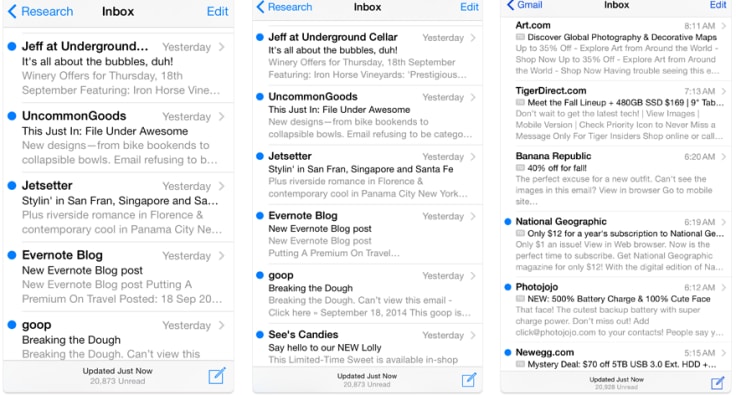
Keep your titles short and remember to work on your preview to avoid cutting them off.
2. Personalize
No one wants to receive a message starting with ‘Hi [blank]’, right? Make sure that even when you’re using a pre-written template, you keep modifying it and testing it every time.
And by modifying, I don’t mean changing the subject, adding a name or a link to one of the articles prepared by your prospect.
Don’t skip your research, and try to go deeper than just a few simple things you can google in 3 minutes. What was it that made you reach out to this person in the first place? Is there anything that you find particularly exciting or mention-worthy?
Include it in your message, your contact will appreciate it.
A real-life example of this approach? Here’s an email from Beamery’s blog:
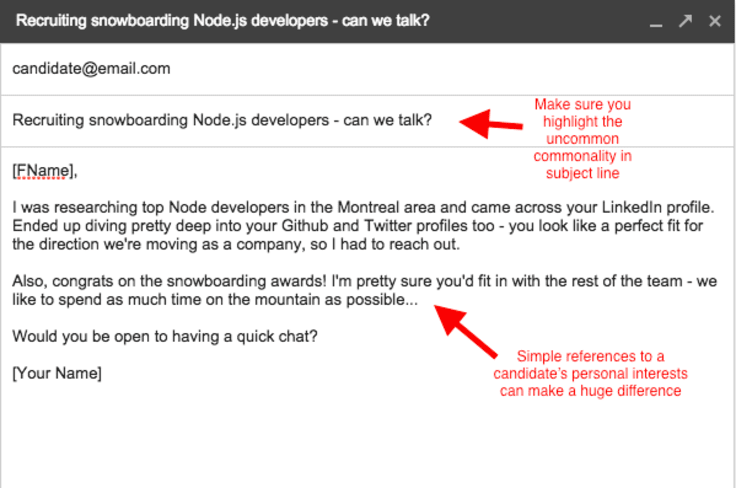
You may have noticed that a very specific detail (in this case, snowboarding) is already mentioned in the email subject. It’s then repeated in the body of the message, as it is to say ‘we’re already connected’. This technique will help you not only increase your open rate but also boost the response rate.
3. Be clear and keep it short
Communicate directly and clearly state what you’d like your contacts to do, whether it is to schedule a meeting or set up a call. And what’s crucial, not only be 100% clear about the means but make sure that you explain as well why you want to set up a call or a meeting with them specifically.
Here’s an excellent example of a very short from a message included in Barack Obama’s re-election email campaign from 2012:
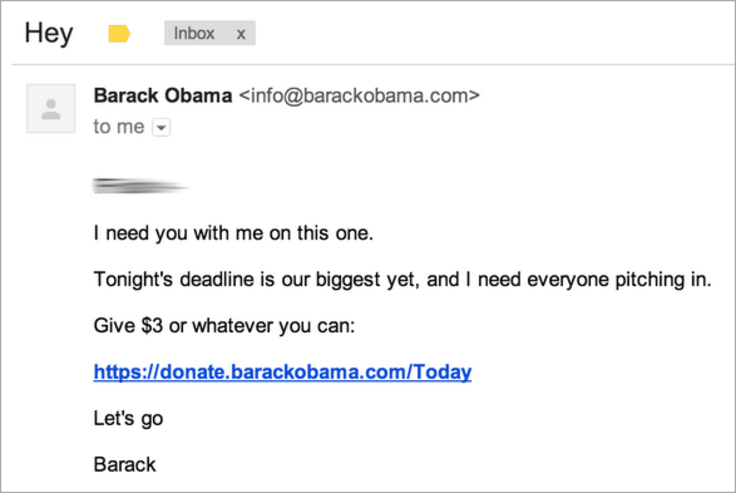
See what they did there? Some may call this approach creepy, but it worked! The people behind the emails saw the engagement and open rates soaring whenever they used subject lines such as ‘Hey’ or ‘Wow’ and kept the copy at the bare minimum in these emails.
4. Stay relatable
Yes, staying relatable is important. Make sure that you sound like a human, not some kind of robot that shoots out emails every few seconds.
Oh, and part of staying relatable is customizing your from field. Make sure that it includes your name and not your company’s name. This way, you increase your chance of getting your email opened.
We use this method at LiveChat Partner Program where we make sure that our partners always receive emails from one member of our team, not all of us listed as ‘Team’ or ‘LiveChat Partner Program.’
Here’s an example of an email you receive when you sign up for a copy of our recently released ‘The Ultimate Affiliate Marketing Guide’ ebook:
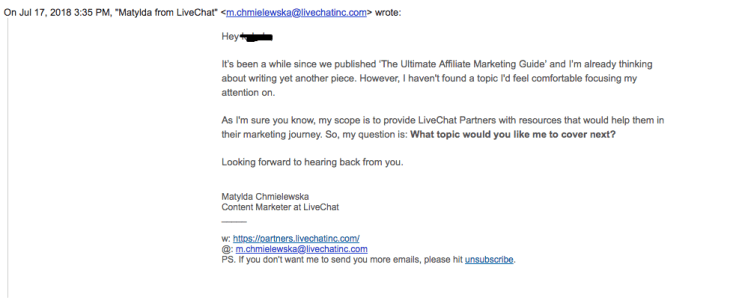
My name is included in the from field and also appears in the footer. Please feel free to steal this approach from us. It not only builds trust but also helps to increase the feeling of connecting to a real human.
5. Do your homework
The rule here is the same as with your research: don’t skip your homework and look for valuable insights that could be helpful to your customers. This may include tips on how they could bring more traffic to their website based on the data or on how they could increase their landing pages’ conversion rate.
Modern marketing tools allow you to spy on almost anything and anyone, so make sure that - while you want to convince your contact that you went an extra mile (which you did!), you don’t want to make it sound too nosy though.
Focus on areas where you could offer them your expertise, instead of detailing every small thing that you know about their business.
Here’s a great example of this approach. The message sounds relatable, it’s short, and this video has undoubtedly drawn some attention from the people contacted:

This is how Proposify’s Kyle Racki writes about it: ‘As soon as this email came into my inbox, the first thing I noticed was an animated image of my own website, the Proposify home page. That was like holding a bag of gummy worms over a toddler’s head and saying, Want this?’
I bet that’s exactly how you want to make your potential customers feel too.
6. Name-drop their current contacts/customers
Noticed any companies mentioned on your contact's website? Saw them at a conference? Mention it in your outreach message to increase the response rate.
Here’s an example of this approach from the email sent out by Mohat Garg of SalesHacker:
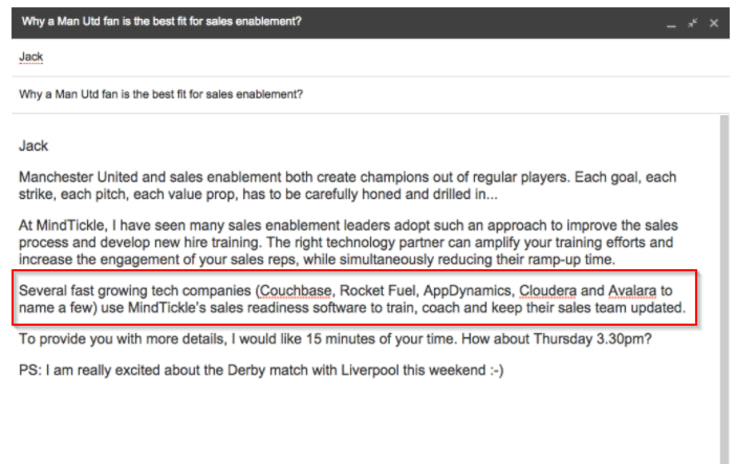
You can copy this approach when preparing your warm emails by including any common ground points and anchors.
This can include listing companies from the prospect’s website that you also collaborate with or mentioning an online networking event that you’ve both attended. Anything that will make them your email sound less awkward and more engaging will be great.
7. Pain points vs. benefits
Start with listing their potential pain points or questions they may have when reading through your offer.
Then it’s time to focus on the benefits. Make sure that you can clearly state how the collaboration between your businesses can positively impact the customer you’re trying to reach through cold email.
Don’t brag though or make false claims that you won’t be able to live up to. Make sure that they sound achievable and that the results will be evident.
8. Offer your help
I’ve mentioned on this blog many times how important creating and offering value is. This approach should be applied to your warm emails too.
Take a look at this message from Uberflip's blog:
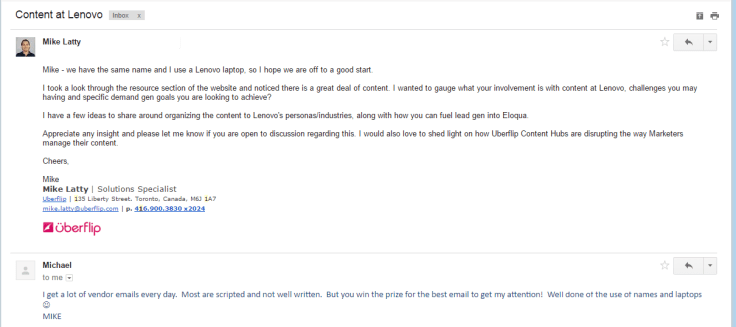
It may feel a bit too intrusive sending an email like this at first but once again, it goes down to doing your homework and coming up with valuable offering.
9. Leave it open
Make sure that you don’t end you warm email with something generic like ‘Please don’t hesitate to contact me should you have any questions’ as it may not sound too inviting.
I highly recommend finishing your messages off with a simple and relatable question, something that will make your prospects feel like they can and need to respond to.
A great example of this approach is this email example prepared by Val Geiser and described on LeadFeeder’s blog:

According to Val Geiser, she gets 80% open rate whenever she sends messages using this template. What’s interesting here is the fact how highly personable this email is, the smart use of segmentation (this is sent only to people from Twitter), and how short it is (3 sentences only). Now, that’s something to learn from.
10. Follow up the follow-ups
Follow-ups make a difference. There, I said it. They may sound like an unnecessary burden, but in fact, they do work. Keep them at minimal though, and make sure that they’re non-intrusive. Cornering someone into responding will surely not work and be effective in the long term.
Here’s another example from FullStory, also mentioned on the Proposify’s blog. This is the message Kyle received after clicking on the video from the initial email:
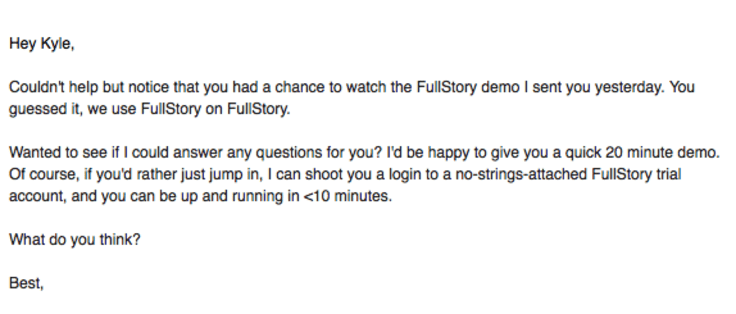
As you can see, the email doesn’t seem too aggressive. It also offers two alternative options for the contact to choose from and mentions the ‘no-strings-attached’ policy which can ease out any concerns about not being able to back out if they don’t like FullStory’s offering.
Over to you
Ok, so that’s all for today! Hope you’ve found these tips helpful. Just to recap here’s a quick list of warm email rules:
- Keep it short.
- Sound like a human.
- Name-drop any points of connection.
- Research, personalize, and go the extra mile.
- Offer your help, and end your email with an open question.
- Always follow up.
Here are also some extra tips from a self-proclaimed 'email conversion geek', Laura Lopuch:
Laura LopuchNot sure where to start with cold emails? Look at the emails that you get opened. Analyze and compare them against each other to figure out what’s working in an email – this is where I start whenever I’m writing a new type of email. This trick gives you a clear idea of how to write your own cold email.
Next up: do some research -- aka light Internet stalking -- on the person you'd like to cold email. Figure out what their business goal is and how your product/service helps them solve it.
Hint: their biz goal is likely 1 of these 3 things: make more money, reduce expenses, look more awesome to their boss/colleagues.
So, in your cold email, be ultra-relevant to your email recipient's goal and help them answer the question in their head: "What's in it for me?" If you do that, you'll be ahead of 99% of the cold emails out there.{{< /block/quote >}}
Have you used any of these techniques in your sales or marketing outreach emails? I’d love to read your story in the comments below.
If you're interested in business collaboration opportunities, I also highly recommend checking our Solution Partner Program to read more about how we could work together.



